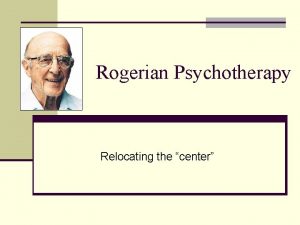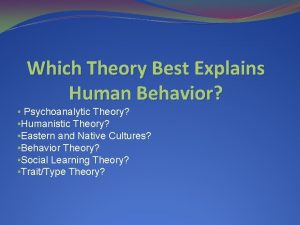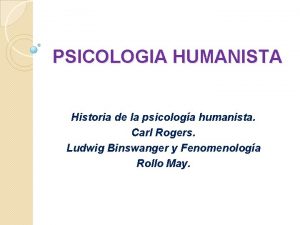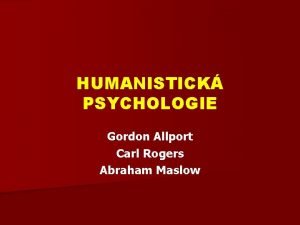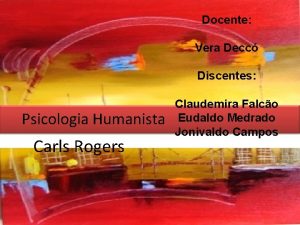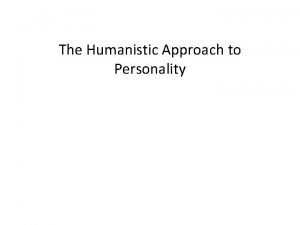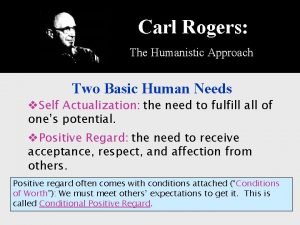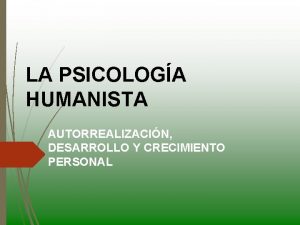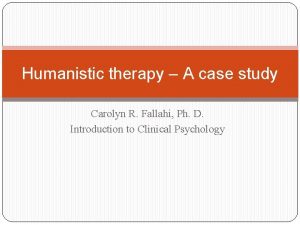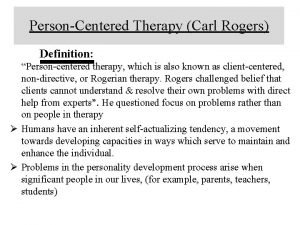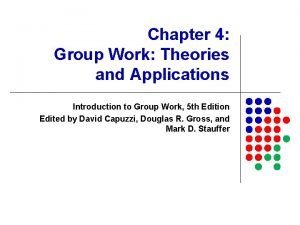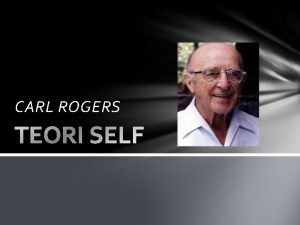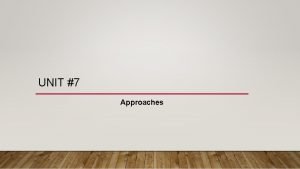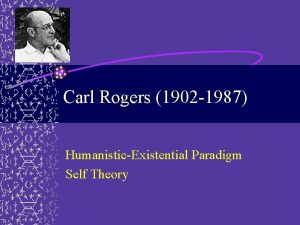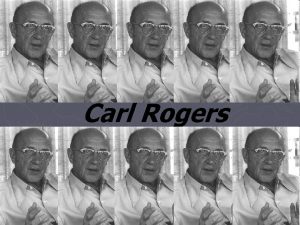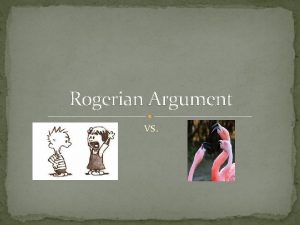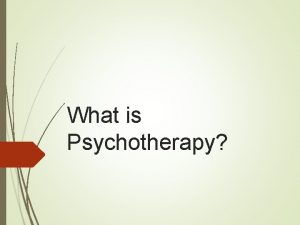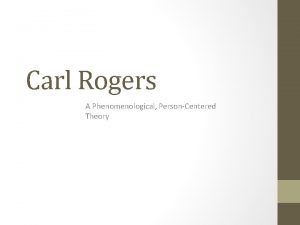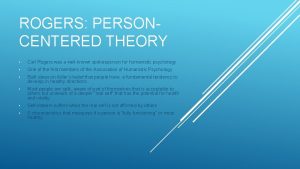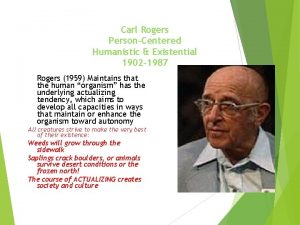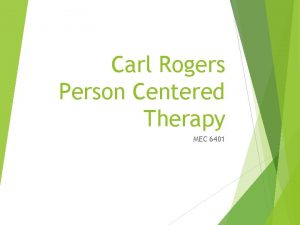Rogerian Psychotherapy Relocating the center Carl Rogers n




















- Slides: 20

Rogerian Psychotherapy Relocating the “center”

Carl Rogers n Born in suburb of Chicago (Oak Park) in 1902 n Strict, controlling, religious parents n Childhood spent in solitary pursuits n 2 years at the Union Theological Seminary n Ph. D clinical psychology from Columbia University Teachers College in 1931 n Formulated essentials of person-centered therapy in 1940 n Continued to write and lecture into his 80 s n Died in 1987 Natalie Rogers

Experience: Foundation of Rogerian theory Carl Rogers, On Becoming a Person (pages 23 -24). n Experience is, for me, the highest authority. The touchstone of validity is my own experience. No other person's ideas, and none of my own ideas, are as authoritative as my experience. It is to experience that I must return again and again, to discover a closer approximation to truth as it is in the process of becoming in me. n Neither the Bible nor the prophets ~ neither Freud nor research - neither the revelations of God nor man - can take precedence over my own direct experience. n [. . ] My experience is not authoritative because it is infallible. It is the basis of authority because it can always be checked in new primary ways. In this way its frequent error or fallibility is always open to correction.

Assumptions about human nature q Human beings are innately good q Value of life is in present q Human beings are purposive & goal-directed q Basic human need: Deep human relationships, unconditional positive regard from others q Core of human life resides in self-experience q Client’s behavior understood from a phenomenological approach "It is the client who knows what hurts, what directions to go, what problems are crucial, what experiences have been deeply buried. " -- On Becoming a Person

Personality theory: A few of the 19 propositions n All persons are in the center of a continually changing world of experience (phenomenal field). The person’s perception of this field is his/her "reality“ (1, 2) n The organism has one basic striving: to actualize, maintain, and enhance itself (4) n As a result of interacting with the environment, the person develops a sense of self or self concept, consisting of images and beliefs (9) n What I am (self-identity) n What I can do (self-efficacy) n How I think/feel about myself (self-esteem) n Behavior is the organism’s goal-directed attempt to satisfy its needs as experienced, in the field as perceived (5) n Behavior is usually consistent with self-concept. When behavior is inconsistent with self, it is usually not “owned” by the person (12, 13) n Emotion accompanies and usually facilitates such goal directed behavior (6)

A few more propositions: (Psychological health) n Psychological adjustment exists when the self concept allows the person to assimilate all sensory and visceral experiences into a consistent self. This is congruence. (14) n Psychological maladjustment exists when the person denies to self significant sensory and visceral experiences (because they are inconsistent with the person’s ideal self, the type of person that one believes one ought to be). This results in incongruence between the real self and the ideal self. (15) n Incongruence = Neurosis n Increased and continued incongruence can lead to psychosis n Under certain conditions, involving primarily complete absence of threat to the self structure, experiences which are inconsistent with it may be perceived and examined, and the structure of self revised to assimilate and include such experiences.

Case Example: Mr. Smith Self-Concept “How I see me” Ideal self “How I should be” Fearful Insecure Lonely Manipulative Gullible Smart Content Secure Lonely Honest Skeptical Smart Incongruence

On Psychopathology n No dividing line between normality and psychopathology. n Rejection of diagnostic labels: Rogers considered “. . . such categories as pseudoscientific efforts to glorify therapist’s expertise and depict the client as a dependent object. . ” (Rogers, 1951) n Defenses: Organism’s response to experiences that threaten the self-concept (distortion, denial) n Neurosis: Powerful conditions of worth in self-concept. Incongruent with totality of experience. n Psychosis: Person is badly hurt by life, needs corrective influence of a deep interpersonal relationship.

Psychopathology

Therapeutic Process q The therapeutic relationship is the primary intervention ". . . In my early professional years I was asking the question: How can I treat, or cure, or change this person? Now I would phrase the question in this way: How can I provide a relationship which this person may use for his own personal growth? " -- Carl Rogers, On Becoming a Person. q Most Freudian methods explicitly rejected q No couch q No use of interpretation q No investigation of client’s past q No dream analysis

Therapeutic Relationship (continued) q Client must perceive three characteristics in therapist: 1. Unconditional positive regard: Nonjudgmental, non-possessive respect and caring for client’s self-concept and feelings 2. Empathy: attuned to the client’s feelings and beliefs 3. Genuineness: in touch with (and shares) own personal experience

Unconditional Positive Regard n Nonjudgmental acceptance “People are just as wonderful as sunsets if you let them be. When I look at a sunset, I don't find myself saying, "Soften the orange a bit on the right hand corner. " I don't try to control a sunset. I watch with awe as it unfolds. ” ― Carl Rogers, A Way of Being “The more I can keep a relationship free of judgment and evaluation, the more this will permit the other person to reach the point where he recognizes that the locus of evaluation, the center of responsibility, lies within himself. ” ― Carl Rogers, On Becoming a Person “The curious paradox is that when I accept myself just as I am, then I can change. ” ― Carl Rogers, On Becoming a Perosn n Intentionally non-skeptical “The kind of caring that the client-centered therapist desires to achieve is a gullible caring, in which clients are accepted as they say they are, not with a lurking suspicion in therapist's mind that they may, in fact, be otherwise. This attitude is not stupidity on therapist's part; it is the kind of attitude that is most likely to lead to trust. . . ” ― Carl Rogers

Empathy Evidence for an empathic civilization n “To perceive the internal frame of reference of another with accuracy and with the emotional components and meanings which pertain thereto as if one were the person, but without ever losing the "as if" condition. “Thus, it means to sense the hurt or the pleasure of another as he senses it and to perceive the causes thereof as he perceives them, but without ever losing the recognition that it is “as if” I were hurt or pleased and so forth. ” n “When the other person is hurting, confused, troubled, anxious, alienated, terrified; or when he or she is doubtful of self-worth, uncertain as to identity, then understanding is called for. The gentle and sensitive companionship of an empathic stance… provides illumination and healing. In such situations deep understanding is, I believe, the most precious gift one can give to another. ”

Genuineness n “In my relationships with persons I have found that it does not help, in the long run, to act as though I were something that I am not. ” ― Carl R. Rogers, On Becoming a Person n “In place of the term “realness” I have sometimes used the word “congruence. ” By this I mean that when my experiencing of this moment is present in my awareness and when what is present in my awareness is present in my communication, then each of these three levels matches or is congruent. At such moments I am integrated or whole, I am completely in one piece. Most of the time, of course, I, like everyone else, exhibit some degree of incongruence. I have learned, however, that realness, or genuineness, or congruence—whatever term you wish to give it—is a fundamental basis for the best of communication. ” ― Carl R. Rogers, A Way of Being

Therapeutic goals q Specific goals determined by therapist and client based on client’s specific circumstances q General (meta) goals include helping clients… q abandon the defensive facades that protect incongruent self -concept q accept anxiety-provoking aspects of self-experience q move from incongruence to congruence video demonstration with Gloria Demo starts at 9: 30

Case Example: Mr. Smith begins therapy Self-Concept Ideal Self “How I see me” “How I should be” Lonely Insecure Authentic Fearful Cautious Gullible Cautious Smart Manipulative Assertive Content Secure Authentic Cautious Lonely Honest Authentic Skeptival Cautious Smart Moving toward Congruency

Criticisms n Overly optimistic and simplistic view of human nature n Three therapeutic conditions are necessary but insufficient n Implies therapist must be congruent n Diagnosis has benefits n Therapeutic confrontation can be beneficial

Research n Some studies of genuineness, empathy, and unconditional positive regard found that these three characteristics were related to constructive change in therapy. Other studies have found no relationship (Epstein, 1980) n Self-concept has also been studied. Research supports notion that therapy is usually related to increased selfacceptance (Wylie, 1984)

Dibs In Search of Self n What is Dibs like when he first meets Miss A? n n n Was he mentally retarded? Was he autistic? Would he meet DSM criteria for some other disorder? n How did he develop the behaviors above n n n From an Adlerian perspective? From a Rogerian perspective? Bruno Bettelheim: “The Empty Fortress” n What did Axline think Dibs needed in order to improve? n How did she try to treat Dibs? n n Why did she insist on her clinic (rather than his home)? What kind of limits did she set? What was their purpose? n How might a different type of therapist work with Dibs?

Diagnostic criteria (Autism) n A total of six (or more) items from (1), (2), and (3), with at least two from (1), and one each from (2) and (3): n qualitative impairment in social interaction, as manifested by at least 2 of the following: n n n qualitative impairments in communication as manifested by at least 1 of the following: n n n marked impairment in the use of multiple nonverbal behaviors such as eye-to-eye gaze, facial expression, body postures, and gestures to regulate social interaction failure to develop peer relationships appropriate to developmental level a lack of spontaneous seeking to share enjoyment, interests, or achievements with other people (e. g. , by a lack of showing, bringing, or pointing out objects of interest) delay in, or total lack of, the development of spoken language (not accompanied by an attempt to compensate through alternative modes of communication such as gesture or mime) in individuals with adequate speech, marked impairment in the ability to initiate or sustain a conversation with others stereotyped and repetitive use of language or idiosyncratic language lack of varied, spontaneous make-believe play or social imitative play appropriate to developmental level restricted repetitive and stereotyped patterns of behavior, interests, and activities, as manifested by at least 1 of the following: n n encompassing preoccupation with 1 or more stereotyped & restricted patterns of interest that is abnormal in intensity or focus apparently inflexible adherence to specific, nonfunctional routines or rituals stereotyped and repetitive motor mannerisms (e. g. , hand or finger flapping or twisting, or complex whole-body movements) persistent preoccupation with parts of objects n Delays or abnormal functioning in at least one of the following areas, with onset prior to age 3 years: (1) social interaction, (2) language as used in social communication, or (3) symbolic or imaginative play.
 19 propositions rogers
19 propositions rogers Real self definition
Real self definition Carl rogers theory
Carl rogers theory Perspectiva humanista
Perspectiva humanista Carl rogers abraham maslow
Carl rogers abraham maslow Quien fue rogers
Quien fue rogers Psicologia humanista
Psicologia humanista Humanistic theory
Humanistic theory Carl rogers self actualization
Carl rogers self actualization Mapa conceptual de carl rogers
Mapa conceptual de carl rogers Teoría del crecimiento personal
Teoría del crecimiento personal Carl rogers case study
Carl rogers case study Carl rogers theory
Carl rogers theory Carl rogers theory
Carl rogers theory Biografi carl rogers
Biografi carl rogers 7 approaches to psychology
7 approaches to psychology Carl rogers theory
Carl rogers theory Villkorslös kärlek psykologi
Villkorslös kärlek psykologi Campo fenomenal
Campo fenomenal Les 10 principes de carl rogers
Les 10 principes de carl rogers Carl rogers self theory
Carl rogers self theory
